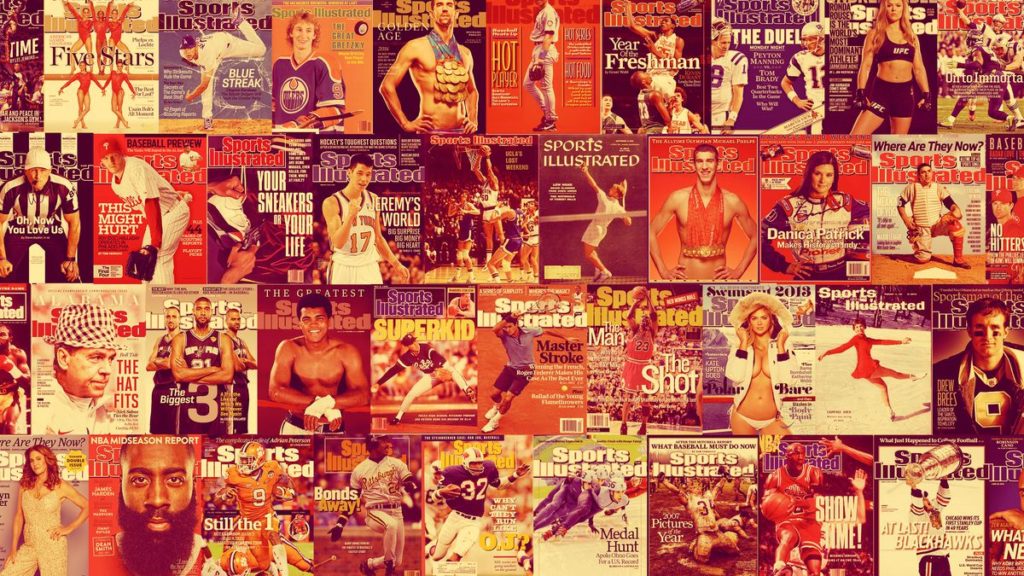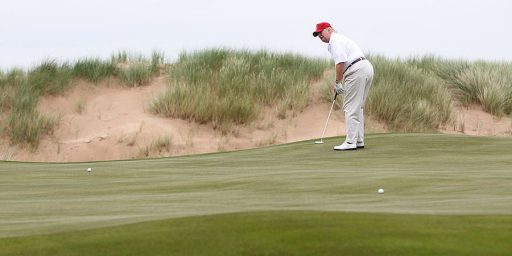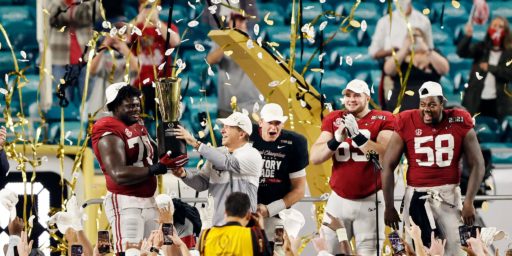Sports and Body Types
Athletes are getting bigger and stronger. Except those who aren't.

While hardly the most pressing thing going on in the world at the moment, the juxtaposition of two stories on the front page of ESPN.com struck me as interesting.
The first (“Bryson DeChambeau just proved his get-big experiment is a winning formula“) concerns a golfer of whom I had never heard until this morning.
After six top-10 finishes in a row, Bryson DeChambeau has found the winning formula.
After all the experiments, tinkering with equipment, angles and math, bulking up and adding distance, DeChambeau put everything together and won the Rocket Mortgage Classic in Detroit. He did it while many on the outside questioned if his strategy made any sense, if it were sustainable and if it would ever pay off.
[…]
Most recently, he used the time off from the tour, a three-month layoff forced by the coronavirus pandemic, to tinker with the formula, deciding to put on 20 pounds to add mass and speed for more distance. He averaged 340.4 yards off the tee at the Charles Schwab Challenge and showed what he had been working on in his laboratory.
“He’s changed the way the game is played entirely,” Kevin Kisner said to CBS after the Rocket Mortgage Classic.
Each week — his weight gain is now up to 40 pounds — the farther DeChambeau hit the ball, the more heads started to turn.
As is the case with anything new or different, though, skepticism was still rampant. Finishing in the top 10 week after week is impressive, but it’s not winning.
[…]
Despite his going 46 under par in his first three tournaments, without a win, credit was not given to DeChambeau. The added muscle was all for show if it didn’t get him on top of the leaderboard.
[…]
He isn’t just hitting it far off the tee. He’s also scoring, and he has been in the hunt in every tournament since the return of golf in June. His driver is going a mile, but having more distance in his irons is also going to pay off in the long run.
Hitting a 9-iron, a high-percentage club, from 190 yards out is not an option for most players. It is for DeChambeau, and he’s using it to his advantage.
[…]
“Yeah, there’s no secret that hitting the ball far is a huge advantage,” Viktor Hovland said. “Now, you’ve got to hit it straight as well to gain all the shots like [he] has been gaining to the field. I think, you know, you can look at him and say, ‘Oh, that’s crazy, I would never do that.’ But the fact is that it works.”
He’s done well in a small string of tournaments, finally winning a minor one. We’ve seen big, strong guys win golf tournaments before. Unless he does it consistently and in majors, this is a blip, not a trend.
Indeed, Tiger Woods revolutionized the game two decades ago in a similar fashion. He had enormous talent and practiced like a maniac but he was also a physical marvel, training hard to be much stronger and fitter than was the norm in golf. (Ultimately, his body broke down and some speculate performance-enhancing drugs were at work.) That forced others to do the same. If DeChambeau keeps winning, it’ll have a similar impact.
By itself, the story is only moderately interesting. But contrast it with “How NFL offensive linemen escape the 5,000-calorie lunch and transform in retirement.” It’s filled with anecdotes and photos you’ll need to see for yourself for the full impact.
It describes a handful of the biggest of football’s big men, how hard it is for them to bulk up to compete, and the rapid weight loss and health improvements some have had after leaving the game.
A lot of the weight is artificial to begin with. As [Jordan] Gross points out, “not many people are naturally that big,” but bulking up was essential to playing at the highest level and making millions of dollars. Gross, for example, ingested an enormous amount of protein each day while playing, including six pieces of bacon, six scrambled eggs, two 50-gram protein shakes, four hard-boiled eggs and two chicken breasts — all before 2 p.m. in the afternoon.
It’s a somewhat new phenomenon, according to Dr. Archie Roberts, a 1965 draft pick of the Jets who went on to become a cardiac surgeon. In 2001, Roberts co-founded the Living Heart Foundation, which annually conducts health screenings for retired football players. “In the 1990s, there was a push that suggested to some people that putting on more weight might make it a more effective and exciting game,” Roberts said. “Because the bigger offensive linemen could hold off the defensive rush for a longer time so that the quarterback could throw the ball down the field, leading to more spectacular passing plays.”
Playing weights began ballooning across the league, especially on the line. According to Elias Sports Bureau research, the average weight of starting offensive linemen was 254.3 pounds in 1970. It jumped to 276.9 by 1990, but the largest increase in poundage would come in the following 10 years. A decade later, the average O-line starter checked in at 309.4 pounds. Today the number stands at 315, more than 60 pounds heavier than 50 years ago.
Hawley typically played between 295 and 300 pounds, but during his fifth year in the league, he adopted the paleo diet and ate clean. He lost 10 to 15 pounds and played the following season at 285. “It was hard to keep weight on eating clean like that, but I felt so much better,” Hawley said. “I had so much energy; I wasn’t as lethargic.”
Then, he re-signed in Tampa Bay.
“Because I was getting pushed around a little bit playing on the offensive line that way, they told me I needed to gain weight,” Hawley said. “So I went to a more unhealthy diet, which made me feel, well, not as good. But it’s what I had to do to play.”
“Being skinny as a lineman wouldn’t be helpful, because you would have to create more force to stop those big guys,” Thomas said. “Inertia becomes an issue. I’m a big, fat guy, you’re running at me, you don’t have to create as much force because I’m just heavier, fatter and have more mass.”
The article goes on to talk about the health benefits and quality-of-life improvements these men experience, almost immediately, from their new lifestyles. Concussions and broken bones aren’t the only sacrifice our modern gladiators make to entertain us, with a relative few getting life-changing wealth in trade.
I find it fascinating that, as long as spectator sports has been a huge business, we’re continuing to learn big, new things about performance.
But even football players weren’t routinely lifting weights and bulking up half a century ago—within my lifetime. And even in the four decades or so I’ve been actively following sports, we’ve seen rather radical changes. In football, the game I follow the most closely, players are incredibly bigger, faster, and stronger now than they were then. We have quarterbacks in 2020 bigger than some linemen were in 1980.
It’s not only not surprising that golfers and even race car drivers are getting stronger and fitter but rather remarkable that it’s taken as long as it has.






It’s not just in sports. Movies are obsessed with ripped guys. In a time of male insecurity and loss of status, secondary sexual characteristics take on new importance. This is basically boob jobs for men.
Given the issues with concussions and player health overall, I wonder why the NFL doesn’t set weight limits for every position.
@Michael Reynolds: Yes, it’s truly remarkable that even characters that are supposed to be 98-pound weaklings are played by 190-pounders with two percent body fat.
Still, I think there’s something going on here other than an obsession with appearance, at least in sports. Body type matters a lot in performance. But trends change: some teams emphasize size and others speed.
The “big man” is all but out of fashion in the NBA nowadays, at least at the center position that used to dominate the game. At the same time, though, we have guards and forwards who are massive compared to their 1970s and 1980s forebears.
@James Joyner: in the NBA you have physical freaks, like 7-footers who can bring the ball up the court and then shoot a 3.
Being 7 foot tall is so rare, that if you’re a 7’ tall grown man in America there’s a greater than 10% chance you’ve played in the NBA.
@Michael Reynolds: compare the 1973 Walking Tall with the 2004 Walking Tall
In college I was friendly with a guy who was a body builder and weight lifter. He had some specific goals in mind and particular competitions that he looked to participate in. As I recall it took him several years to build his body up to the size/strength/shape he needed. He did achieve his desired level of success and spent nearly as long working out to shrink his body back to normal, rather than have all the muscle turn to blubber.
He’s the 7th-ranked player in the world (up from 10th before his win yesterday). He has ranked as high as 5th in the past, including ending the 2018 season at 5th after winning 4 times that year. He has 8 career wins, at age 26.
He has also been an ongoing journalist’s dream, with endless stories being written about his analytical approach, the way he cut all of his irons to identical lengths, his self-taught swing and putting stroke with essentially no arm flex, the driver’s cap that he wears instead of the ubiquitous baseball cap, and the ridiculous PGA ruling that forbade him using a protractor on the course on the grounds that it is a “calculating device”. That you had not heard of him is a bit odd if you care about golf at all.
I play golf at least twice a week, pretty much every week. More when I’m in Florida, Texas or Georgia.
Bryson DeChambeau is just one of an amazing pool of young talent on the PGA tour. Now, before anyone gets too worked up over his newfound success, keep in mind that he has 6 wins and alot of other top finishes – but no majors. Golf success is defined by majors. Jordan Speith, also 26, has three majors. Brooks Keopka had three by 26 and has 4 total. Rory had 3 by 26 and has 4 total.
Additionally, golf has a way of humbling great players. Bryson DeChambeau is on a good roll right now. But Jordan Speith can barely put the ball in play right now. Tiger woods lost his swing – twice, and had to rebuild it.
Let’s hold off on crowning DeChambeau as the next great thing until he can put together a few seasons like this, and win a major or two.
Lastly, Bryson DeChambeau looks at golf like a scientist, not an athlete. His attention to detail is unrivaled on the tour. Before a tournament where they were expecting rain, he spent days hitting wet golf balls while his launch monitor tracked the ball flights. He was able to change which golf ball he played in that tournament to minimize the rain’s effect on the ball flight.
Golf is a precise game these days, with players having access to stats that just weren’t available to them even 15 years ago. Things like launch angle, ball speed, smash factor, sidespin, backspin, apex, curve, swing speed are constantly being adjusted via specialized, personalized shafts, balls, clubs and grips. Even putters are part of this technological revolution.
I ran into Kevin Garnett at a club.
Holy crap! He was huge. Mind boggingly huge.
His hands! He could have reached out and crushed my melon like it was an actual melon.
He was 21 at the time. Still called The Kid.
I’m middling sized 5’10”, ~155.
Jinkies, he is a big man.
My brain could properly process his size. Titanic.
@Sleeping Dog:
He was ill-informed, muscle doesn’t turn into fat — the cells are very different and there’s no pathway to transform one kind into the other. What does happen though is that the amount of calories needed to sustain a lot of muscle when you’re working out very hard (say a professional athlete) is much higher than the calories needed to sustain that same muscle when you’re not working out, and the body strictly adheres to use it or lose it. That means the excess calories are turned to fat, and muscle is lost (just as bone density is lost) when it is no longer used.
Basically, a professional athlete with a lot of muscle who cuts back on his or her diet upon retiring won’t gain fat (though they will lose muscle as they’ll be working out much less). But many try to eat after retirement at the same pace as they did when competing, with predictable results.
@Northerner:
I used to do a little photography for body-builders and semi-pro athletes. I learned quite a bit from them.
One thing with body building is that even during the off-season, they still have the same muscle mass–even if they look “soft”. They just allow their body fat to come back. During competition season, they go pure lean in their diets, burn off the fat, and “pump” the muscles (it’s not very much extra mass, they’re just more defined).
And, from what I understand, a lot of the “flabby” look for retired body builders is actually skin–the muscle goes away, but the skin doesn’t shrink back with it.
@Michael Reynolds: I’ve heard a few actors discuss the mechanics of having that ripped bod and it’s startling. As you would expect, dieting is constant along with massive workouts. Then you have to shave any portion of your body that could be exposed. And if a scene calls for shirtlessness they drop and crank out twenty frenetic pushups, jump back up, and then the director calls “action”.
@Northerner:
I knew that guy almost 50 years ago and I suspect he simply reflected the then received knowledge. I’d see him once or twice a year when he was winding down and each time he was still trim, but smaller.
@de stijl: I was at a small technical working conference in Dallas once that included weekend meetings. The hosts had put us up at a snazzy hotel downtown. One evening I got on the elevator and was followed on by four men — as it turned out, four of the offensive linemen that were in town to play against the Cowboys that Sunday. The elevator said it was rated for ten, but the five of us filled it. And I was a skinny little guy! It’s one thing to hear the TV announcer say, “So-and-so is 6-foot-eight and weighs 320 pounds.” It’s a whole ‘nother thing to stand next to them in an elevator.
Well before Tiger came along, the PGA Tour players forced the Tour to provide what was essentially a weight room in a large trailer and make it available to them at every stop. The benefits of strength training have been known for a long time.
Interestingly, now that I am 66, my doctors no longer nag me much about aerobic exercise. But I don’t get out of an appointment without being asked what I’m doing for strength training. They would be happier if I told them that I was lifting three days a week :^)
@Teve:
There’s an old joke about the college basketball coach recruiting a 6’11” high school guy.
“Coach, I’m not much of a shooter.”
“Son, we’ve got an assistant coach who is terrific at teaching shooting.”
“I’m not much of a passer either.”
“Son, we’ve got another assistant who can teach you everything there is to know about passing.”
“But if you’ve got to teach me all that stuff, why are you recruiting me?”
“Son, we can’t teach you how to be 6’11”.”
@Michael Cain:
Thus, Tako Fall, who was all of about 16yo when he began playing basketball, has a 2-way NBA contract. Being 7’6″ has value.
Prince was tiny.
There is a reason he wore stacked heels.
One night Bobcat and I got rockstar parking like two cars down from First Ave front door.
We had a night. Saw some band. Drank some beers. (Pro-tip: if you tip well and are not assholish staff will give you comp tickets to future shows. Be decent and they treat you well.)
Prince was there that night with his bodyguards.
We left apparently seconds after they did.
Our rock star parking spot was now wedged between some pleb’s car up front and a big-ass purple Town Car behind. Guess who that belonged to.
They were waiting for us to scoot so they could navigate their big as a whale car out.
We were wedged hard. Maybe two feet to the front and 18 inches to the Purplemobile at the rear.
It was one of those inch forward cranked left, inch back cranked right things. Back and forth four of five times before you unwedge yourself.
The whole time I’m coaching / distracting and annoying Bob. “Jesus, be careful! Slow and easy, slow and easy. Bobby, you know who that is right?” I’m lucky dude didn’t clock me.
Finally we got free and never kissed his bumper. Crikey that was tense.
What is stupid is that we lived nine blocks away. Coulda walked there in 15 minutes.
@Sleeping Dog:
That makes sense, people once thought tat turned in muscle. Curiously enough, his belief that it did seems to have kept him working out, which would have been good for him, possibly better than knowing that all he had to do to avoid becoming fat was eating less (ie he wouldn’t have had to exercise if he just cut back his eating — and exercise is very important for reasons other than weight loss).
I just came from the gym from a very intense workout done for one reason. I’m not drinking or smoking lately. So there’s one kind of high that’s available to me, and it’s the high you get when you have just zoomed your heart rate up beyond normal levels for a while until your alarm bells start ringing. The high you get for the next few hours, that’s pretty nice.
Look at Dwayne Johnson. Watch his motivation workout videos. If that don’t get you up and slammin’ some iron, nothing will.
“Focus! “